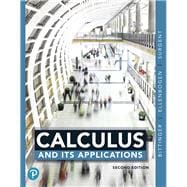NOTE: This loose-leaf, three-hole punched version of the textbook gives you the flexibility to take only what you need to class and add your own notes – all at an affordable price. For loose-leaf editions that include MyLab™ or Mastering™, several versions may exist for each title and registrations are not transferable. You may need a Course ID, provided by your instructor, to register for and use MyLab or Mastering products.
For two-semester courses in Applied Calculus.
Anticipating and meeting student needs
Calculus and Its Applications remains a best-selling text because of its intuitive approach that anticipates student needs, and a writing style that pairs clear explanations with carefully crafted figures to help students visualize concepts. Key enhancements in the 2nd Edition include the earlier introduction of logarithmic and exponential functions to help students master these important functions and their applications.
The text’s accompanying MyLab™ Math course also has been revised substantially, as new co-author Gene Kramer (University of Cincinnati, Blue Ash) revisited every homework question and learning aid to improve content clarity and accuracy. These and all other aspects of the new edition are designed to motivate and help students more readily understand and apply principles of calculus.
The title of this text was formerly Calculus and Its Applications, Expanded Version.
Also available with MyLab Math
MyLab™ Math is the teaching and learning platform that empowers you to reach every student. By combining trusted author content with digital tools and a flexible platform, MyLab Math personalizes the learning experience and improves results for each student.
Note: You are purchasing a standalone product; MyLab Math does not come packaged with this content. Students, if interested in purchasing this title with MyLab Math, ask your instructor to confirm the correct package ISBN and Course ID. Instructors, contact your Pearson representative for more information.











